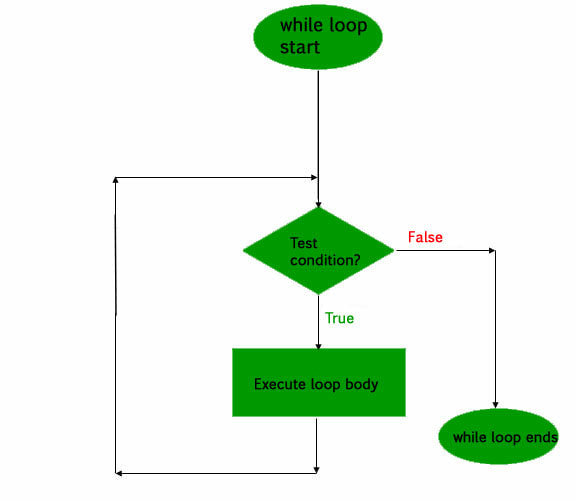While Loop
Every loops has a number pf the same basic elements in it.
1. A beginning
2. An important block of code that needs to be run.
3. A testing condition or statement that judges whether or not to exit the loop.
4. An end
1. A beginning
2. An important block of code that needs to be run.
3. A testing condition or statement that judges whether or not to exit the loop.
4. An end
Here is the flowchart of how a While loop functions
Here is what it looks like in code
While Loop Example
using system;
class whileLoopDemo
{
public static void Main()
{
int x = 1;
while (x <= 4)
{
Console.Writeline("Digitfxtbook.com is amazing!!";
x++;
}
}
}
using system;
class whileLoopDemo
{
public static void Main()
{
int x = 1;
while (x <= 4)
{
Console.Writeline("Digitfxtbook.com is amazing!!";
x++;
}
}
}
Lets look at what is happening in the code above:
1. We start off making sure that everything is organized by creating the class and the method That all of this block of code will live inside of.
2. We then create our counter as an int and name it x
3. We then create the loop with the "while" statement
4. Inside the loop we put all of our important lines of code that need to run. In this example we simply out put a line to the console about this web site
5. Before exiting the loop we increment the counter x adding 1 to it. x++ is the same exact line of code as x = x +1
6. We then close all of our areas (the loop, the method, and the class) with closed }
1. We start off making sure that everything is organized by creating the class and the method That all of this block of code will live inside of.
2. We then create our counter as an int and name it x
3. We then create the loop with the "while" statement
4. Inside the loop we put all of our important lines of code that need to run. In this example we simply out put a line to the console about this web site
5. Before exiting the loop we increment the counter x adding 1 to it. x++ is the same exact line of code as x = x +1
6. We then close all of our areas (the loop, the method, and the class) with closed }
Assignment
Starting off with the code above:
1. Create a simple code breaking program using information in the array.
2. This new program should run 54 times.
3. As the program runs it should determine whether our counter is odd or even.
a. If the counter is on an even number use it to print out the corresponding letter in that place from the array. (remember our friend "modulo" %, it will help you identify which number is even or not)
4. If you code runs correctly then a message should print out to the console and be understandable.
3. Good luck!!!
1. Create a simple code breaking program using information in the array.
2. This new program should run 54 times.
3. As the program runs it should determine whether our counter is odd or even.
a. If the counter is on an even number use it to print out the corresponding letter in that place from the array. (remember our friend "modulo" %, it will help you identify which number is even or not)
4. If you code runs correctly then a message should print out to the console and be understandable.
3. Good luck!!!
Information in the Array
char[] array1 = new char[] { 'A', 'D', 'Z', 'i', 'n', 'g', 'r', 'i', ';', 't', 'f', 'a', 'Q', 'l', 'S', '_', 'w', 'F', 'J', 'X', 'p', 'T', 'X', '_', 'y', 'b', 'w', 'o', 'b', 'o', 'h', 'k', 'u', '_', 'E', 'i', 'M', 's', '<', '_', '?', 'A', 'k', 'm', 'p', 'a', 'U', 'z', 'A', 'i', 'H', 'n', 'v', 'g' }
